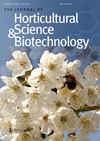Improving pollination of almond (Amygdalus communis L., Rosaceae) using electrostatic techniques
IF 2.1
4区 农林科学
Q2 HORTICULTURE
Journal of Horticultural Science & Biotechnology
Pub Date : 2001-01-01
DOI:10.1080/14620316.2001.11511352
引用次数: 16
Abstract
Summary Supplementary pollination of almond using electrostatic techniques was tested in a three year study (1996–1998) in Northern Israel. We used an electrostatic pollination device and tested its effects on fruitlet set, fruit set, yield weight and nut weight. We also tested its ability to pollinate flowers on the tree from the distal to the proximal part of the branches. We found that when individual branches were pollinated, fruitlet set was in accordance with the expected deposition rate of pollen grains on the stigma: electrostatic 1 open pollination > non-electrostatic + open pollination + open pollination > electrostatic pollination > non-electrostatic pollination > spontaneous self pollination. Fruit set results showed the same pattern but were not as precise. Electrostatic pollination of individual trees resulted in an insignificant increase in pollen germinability on the stigma. The highest germinability was on the distal part of the branch and the lowest was on the proximal part of the branch, in all pollination treatments. Electrostatic pollination increased yield as compared with non-electrostatic and open pollination. Nut weight, however, decreased slightly with increased yield. We suggest that electrostatic pollination can be an important method for pollen supplementation in almond orchards when honeybee pollination is insuf®cient and when the trees can withstand the added portion of nuts, resulting from improved pollination.利用静电技术改善蔷薇科杏仁(Amygdalus communis L., Rosaceae)授粉
1996-1998年在以色列北部进行了一项为期三年的研究,试验了利用静电技术对杏仁进行辅助授粉。采用静电传粉装置,试验了静电传粉对坐果、坐果、产量和果重的影响。我们还测试了它从树枝的远端到近端对树上的花授粉的能力。我们发现,在单枝授粉时,小实子的形成符合花粉粒在柱头上的预期沉积速率:静电1开放授粉>非静电+开放授粉+开放授粉>静电授粉>非静电授粉>自发自花授粉。果盘结果显示了相同的模式,但不那么精确。单株静电授粉导致柱头上花粉萌发能力的增加不显著。在所有授粉处理中,枝条远端萌发率最高,枝条近端萌发率最低。与非静电授粉和开放授粉相比,静电授粉提高了产量。然而,随着产量的增加,坚果重量略有下降。我们认为,当蜜蜂授粉不足时,当树木能够承受增加的坚果部分时,静电授粉可能是杏仁果园花粉补充的重要方法,这是由于授粉的改善。
本文章由计算机程序翻译,如有差异,请以英文原文为准。
求助全文
约1分钟内获得全文
求助全文
来源期刊
CiteScore
3.90
自引率
5.30%
发文量
67
审稿时长
3 months
期刊介绍:
The Journal of Horticultural Science and Biotechnology is an international, peer-reviewed journal, which publishes original research contributions into the production, improvement and utilisation of horticultural crops. It aims to provide scientific knowledge of interest to those engaged in scientific research and the practice of horticulture. The scope of the journal includes studies on fruit and other perennial crops, vegetables and ornamentals grown in temperate or tropical regions and their use in commercial, amenity or urban horticulture. Papers, including reviews, that give new insights into plant and crop growth, yield, quality and response to the environment, are welcome, including those arising from technological innovation and developments in crop genome sequencing and other biotechnological advances.

 求助内容:
求助内容: 应助结果提醒方式:
应助结果提醒方式:


